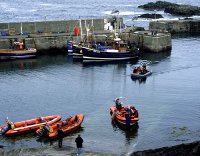 |
|
|||||||||||||||||||||||||||||||||||||||||||||||||||||||||||||||||||||||||||
|
||||||||||||||||||||||||||||||||||||||||||||||||||||||||||||||||||||||||||||
|
|
||||||||||||||||||||||||||||||||||||||||||||||||||||||||||||||||||||||||||||
|
||||||||||||||||||||||||||||||||||||||||||||||||||||||||||||||||||||||||||||
|
At the north of the Marine Reserve stands the bold promontory of St. Abbs Head, with cliffs rising to a height of three hundred feet. In clear weather there are magnificent views from various points on the headland; one can see the coast of Northumberland and the Farne Islands to the south, and the Bass Rock, the Isle of May, and the Forfarshire coast to the north.
The greatest concentration of seabirds at St. Abb's Head - there are about 50,000 in total - are on the cliffs and stacks north-west of the lighthouse. There you will see Shags which are large all black birds nesting close to the water. In summer you maybe lucky enough to find a few puffins on bouldery slopes out of reach of Foxes and other predators, but very few nest at St. Abbs. The ancient volcanic rocks of the Head have formed sheer cliffs and pinnacles with ledges suitable for seabirds but without beaches beneath. These birds require inaccessible sites like those to escape from animals which might take eggs of chicks, and also because they need easy access to the sea. Indeed Guillemots and Razorbills must have a clear drop to the water because their young leave the ledges before they can fly. They tumble from their ledges to the water, and it is several weeks before they are able to take flight. True seabirds depend entirely on the sea for their survival, travelling many miles to bring back food for their young. Guillemots, Razorbills and Puffins chase fish underwater, using their wings as flippers and their feet as rudders. Shags propel themselves underwater largely with their feet, while Kittiwakes pick food from near the surface of the sea while in flight. Herring gulls, though coastal nesting, feed extensively inland, and so cannot strictly be regarded as seabirds. Kittiwakes by artist, Raymond Harris Ching.
|
|
||||||||||||||||||||||||||||||||||||||||||||||||||||||||||||||||||||||||||
|
St. Abbs & Eyemouth Voluntary Marine Reserve. |
||||||||||||||||||||||||||||||||||||||||||||||||||||||||||||||||||||||||||||


